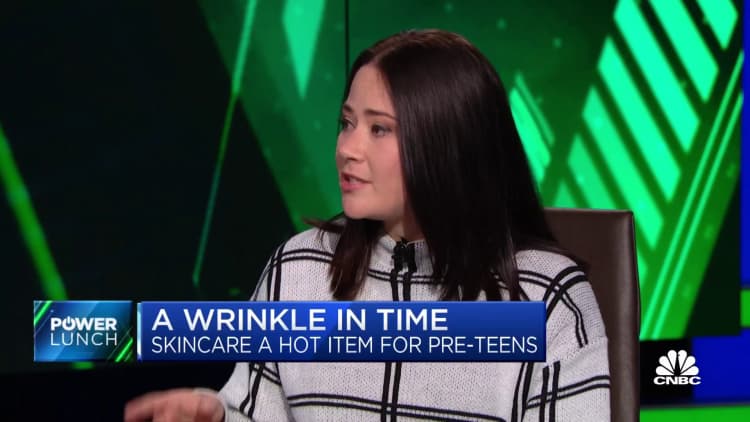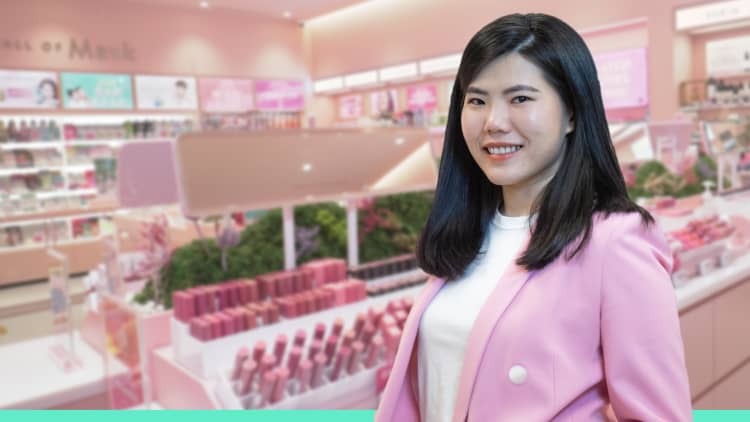
When Melissa Fuentes imagined the Christmas gifts she’d buy for her 9-year-old Tatiana, she figured she’d want Barbies, Bratz dolls or a scooter – the kinds of things she found under her tree growing up in the ’90s.
Instead, something unexpected made it to the top of the list this year: skin care.
“I would have never imagined that I would be buying moisturizer” for a child, Fuentes, 31, told CNBC from Coral Springs, Florida. “There’s this obsession with moisturizing. … That’s all she’s really into right now. Cheerleading, and taking care of her face.”
Fuentes is not the only parent who will be hitting the skin-care aisle for their kids this holiday season.
In an age where TikTok and YouTube have replaced linear TV for America’s youngest consumers, kids are adopting skin-care routines like never before as they absorb content online from so-called Skinfluencers, experts said.
Many kids from Generation Alpha, which are children born in 2010 and later, have become budding experts in serums, toners, moisturizers and sunscreens. In their quest to mimic the cool teenagers they’re watching on social media, some know more about the ingredients in those products than their parents do.
As the new generation of skin-care enthusiasts floods the beauty aisle, new brands catering exclusively to Gen Alpha are cropping up and retailers are cashing in on what parents say has become an obsession. During the crucial holiday shopping season this year, Gen Alpha’s fascination with skin care is expected to fuel a boon in sales.
“[We] know from some of our proprietary research, as we enter into the holiday season, that skincare is one of the categories that is at the top of their list,” Ulta Beauty’s chief merchandising officer, Monica Arnaudo, said of the Gen Alpha consumer.
Walmart is expanding the price points in its beauty department. It recently added a “Beauty finds” display with makeup, skincare, hair and other items for $3, $5 or $9 each. It also sells prestige brands through a new deal with British beauty retailer SpaceNK.
Melissa Repko | CNBC
Both Bubble and e.l.f. Beauty – two brands that have used TikTok to win over young consumers – also said they expect sizable sales this holiday from parents looking for gifts for their Gen Alpha kids.
“We definitely see it on TikTok. We’ve seen a lot of kids and a lot of people are posting their holiday wish list [and we’re] getting tagged very often,” Shai Eisenman, Bubble’s founder and CEO, said in an interview.
Tarang Amin, CEO of e.l.f., said young people’s burgeoning interest in skin care is part of the reason the company has invested in the category, including through its recent acquisition of skin-care company Naturium.
“It’s never too soon to take care of your skin, particularly on sun protection,” said Amin.
Generation Alpha’s interest in skin care comes as millennials and Gen Z consumers also lean deeper into the category — a trend that many say began during the Covid pandemic, when people stopped wearing makeup as often and began focusing more on self-care.
Between 2019 and 2022, annual prestige skin-care spending grew from $6.6 billion to $8 billion, according to Circana. As of September, spending is up 14% this year compared with the same period a year ago.
Meanwhile, mass skin-care sales grew from $7.8 billion to $9.2 billion between 2019 and 2022, according to Circana. Spending is up 10% this year, as of September.
Piper Sandler isn’t yet tracking Gen Alpha. But according to its most recent teen spending survey, where the average age of respondents was 15.7, skin-care spending this fall climbed 19% year over year to an average of $122. It was 16% higher than the multiyear average.
That’s no surprise to Salt Lake City dad Rick Aaron, whose daughters Allie, 15, and Katie, 13, have been religious about skin care since they were about 10- and 8-years-old.
“My wife recently purchased a [mini-fridge] to keep all of her and the girls’ skin-care products in, saying that it needs to be refrigerated and will deteriorate over time at room temperature,” said Aaron, 45. “And then my wife has recommended, ‘well it’s not going to be big enough, so maybe we need to buy a second mini fridge just for skin-care products.'”
A photo of just some of the skincare products Rick Aaron’s daughters are using.
Courtesy: Rick Aaron
When asked how much money he spends on his daughters’ skin-care habit each month, he told CNBC he doesn’t know – and doesn’t want to.
“Between the subscriptions and Amazon purchases and store purchases … it’s probably close to, if not over, $1,000 a month,” said Aaron. “I would probably break down in tears if I actually saw a hard figure on it.”
Grown up products on growing faces. Is it safe?
In the bright white lights of the bathroom she shares with her mom, 7-year-old Marley-Rose addresses her camera as she prepares for her nightly skin-care routine.
“Hey guys, it’s me Marley and today I’m doing my skin-care routine,” Marley says in the clip, which was filmed last month and shared with CNBC.
With her hair neatly pulled into matching buns on either side of her head, Marley shows off her Youth to the People superfood face cleanser, a moisturizer from the same brand and a Laneige toner before she begins cleansing and moisturizing her face.
“I’m going to do it upwards because, well, um, if you do it downwards, your face is gonna be droopy at an early age,” Marley explains as she applies the toner.
Two minutes later, Marley ends the clip with a smile and says she’ll be back soon for her next skin-care routine.
“I just never imagined at 7 years old she’s going to come up to me and ask about skin care and wanting to buy it,” Marley’s mom, Karla Joseph, 41, told CNBC in an interview.
Karla Joseph says her daughter Marley-Rose, 8, has become fascinated with skincare and recently spent her birthday at Sephora.
Courtesy: Karla Joseph
She said Marley first became interested in skin care last month after she watched a TikTok video of a teenager doing her routine. After securing some products of her own, Marley now has her own ritual for mornings and nights and shares videos of it on social media.
“It’s a different time, you know? They’re on their phones, they’re on the internet and they see all this stuff and they want to try it,” Joseph said. “I kind of just have to roll with it because this is what they’re exposed to.”
For her eighth birthday last weekend, Joseph took Marley to Sephora and is already preparing to buy her daughter myriad skin-care items for Christmas.
She said her daughter’s interest in skin care is “great,” and better than playing around with makeup. But she’s been researching products to make sure they’re age appropriate.
That diligence is crucial for any parent whose kids are interested in skin care, said Dr. Amy Wechsler, a board certified dermatologist and psychiatrist.
“I love a routine. I think routines in general are a great idea … especially if that routine includes sunscreen,” Wechsler told CNBC in an interview. “But on the flip side … preteens using products that are often too harsh for their skin because they’re adult products is not a good idea.”
Aveeno skincare, a Johnson & Johnson product.
Jodi Gralnick | CNBC
Wechsler, who runs a New York City practice, said her Gen Alpha patients frequently come in with rashes, irritation, dryness, flakiness and even swelling in their faces and eyes from using skin care products that weren’t appropriate for their young skin.
“I had a kid yesterday that she felt some peer pressure at a sleepover and she knew she kind of had sensitive skin, but she tried some mask or some new product that her friends were all using because she wanted to be part of the group, and then she got an itchy rash on her face,” said Wechsler. “The treating it is pretty easy, but you want to prevent that from happening again.”
She said plenty of skin-care products are safe for kids, and a routine could promote self-esteem, as long as it doesn’t become obsessive.
Here come the Gen Alphas
Considering how young Gen Alpha is, and that the generation isn’t done being born, it’s tough to parse out what kind of effect the group is having on skin-care sales. But the age group is on pace to transform the overall consumer landscape.
Gen Alpha is expected to be the largest generation yet, with roughly 2.5 billion people by 2024, and the group is projected to have the greatest spending power in history, according to demographer and social researcher Mark McCrindle. He coined the term Gen Alpha and is considered a leading expert on the generation.
Momo Productions | Digitalvision | Getty Images
By the end of 2024, when the oldest Gen Alphas will be 14, more than $5.39 trillion will be spent on them annually around the world, according to estimates from McCrindle.

That spending dwarfs the purchasing power of millennials and Gen Zs, which is estimated to be around $2.5 trillion and $3 trillion, respectively, according to research and projections gathered by Harvard Business Review.
“They’re the most materially endowed, the most globally connected, the most digitally integrated, they’re going to be the most formally educated we predict as well, so they’re going to be a very influential generation,” said Ashley Fell, a social researcher at McCrindle’s firm who co-wrote a 2021 book with him on Gen Alpha.
“It’s something that every brand should be thinking about.”
If they’re not, Fell said, they risk becoming “irrelevant.”
— CNBC’s Melissa Repko contributed to this report.
Don’t miss these stories from CNBC PRO:

